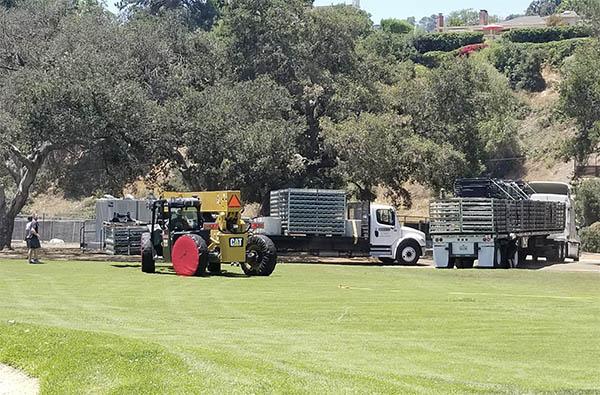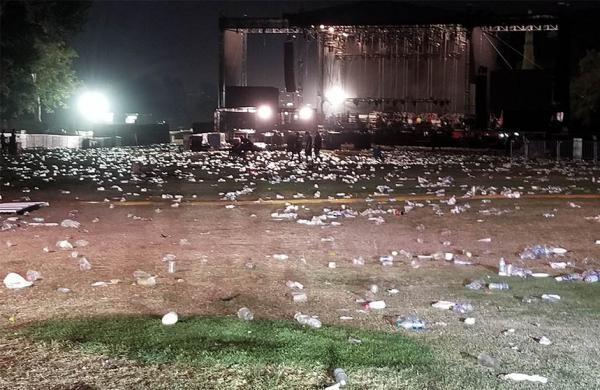
Brookside Golf Course is much more than just 36 holes of ridiculously busy golf in the country's second-largest metropolitan area.
 Located adjacent to the Rose Bowl in Pasadena, California, Brookside doubles as a parking lot for stadium events and, this summer, was the venue for one of the Los Angeles area's largest outdoor, two-day concert events.
Located adjacent to the Rose Bowl in Pasadena, California, Brookside doubles as a parking lot for stadium events and, this summer, was the venue for one of the Los Angeles area's largest outdoor, two-day concert events.As many as 18 times per year, the golf course is a parking lot for about 9,000 cars for UCLA home football games, the Rose Bowl game, concerts and other outdoor events.
That's more than 150,000 cars per year parked on the fairways of a 36-hole facility that does a combined 170,000 rounds per year.
Loosely translated, that's almost one parked car per round of golf per year.
"We are an extremely busy golf course," said superintendent George Winters. "We get about 85,000 rounds on each course. This place is 90 years old. Even without parking and the Rose Bowl, managing this as a golf course would be a challenge."
What Winters and his team are able to accomplish on days when there is an event at the Rose Bowl is nothing short of amazing.
Converting the golf course into a parking lot and back again so as to impose minimal disruption to golfers translates into a lot of crazy hours for Winters and his team. The process includes stripping the golf course of everything that makes it a golf course early in the morning and coming back after each event is over to put everything back together. That means working as many as 16 hours in a 24-hour period and going home after sunrise for just a few hours of sleep. It's so taxing that the crew has a name for it.
"We call it the time machine," Winters said, "because when you're done you have no idea what time it is, or what day it is.
"We're open for golf on event days. Usually, we'll do a 7 o'clock (a.m.) shotgun, or we'll do tee times until about 9. It depends on when the event is that night. I'll have basically what is a weekend crew come in to set up the course for golf, which will be a skeleton crew. The meat of my crew comes in around 9 or 10 in the morning, and we start taking everything off the golf course: tee markers, ball washers, benches, flags, cart signs. We cover all the tee signs. All the bunker rakes come off the course. We strip the course bare, because anything and everything can be used as a projectile when you have 80,000-90,000 people running around."
Before each event, Winters' team also stakes caution tape or rope around every green and all 100-plus bunkers to keep out cars, and powers down the irrigation system.
"Taking the air out and recharging the system puts a lot of undue stress on the system. It's not something you want to do over and over again," Winters said.
"We've had 12 irrigation breaks in five days, including three mainline breaks."
At $40 per car per event, parking at Brookside is an important revenue stream for the city of Pasadena, which owns the golf course and the stadium. It's so important that the golf course, which is managed by American Golf, has 60 temporary lighting towers and a mechanic dedicated to maintaining them to ensure they are always operational.
"Generally what we'll do at the beginning of our event season, which usually begins in May, is we'll put the lights out and we leave them in the rough and out-of-play areas," Winters said.
"We'll go through 600 to 700 gallons of diesel a month just keeping those things ready for use."
We call it the time machine, because when you're done you have no idea what time it is, or what day it is."
Once a stadium event is over and the crowds have left, a crew comes back to work, usually around midnight to 1 a.m. and works under the lights throughout the night and early morning to begin the process of turning Brookside the parking lot back into Brookside the golf course.
Temp workers brought in just for trash removal routinely fill up to six industrial dumpsters after each event. Some of the oddest leftovers among the hundreds of pounds of trash include a pile of scorched hotdogs abandoned on top of the Brookside irrigation satellite, and a tree burning from the inside out after hot coals were dumped at its base.
"Your faith in humanity gets shaken by some of stuff you see out here," Winters laughed. "It's like the clown car of trash. There's a little car, and 15 tons of trash comes out of it. You don't think it's possible, but it happens."
Whether it's daily fee golf, a concert or parking for a football game, there is something happening at Brookside almost every day. Compaction here is an issue, and Winters can't aerify as much as he'd like to relieve it because it's just so busy. Still, this pair of 1928 Charles Blair Macdonald layouts are not for hackers.
"We maintain this golf course to very high standards," said Winters, a 27-year industry veteran who turns 48 on July 29. "Our greens and tees are as good as most country clubs.
"It's like a grow-in after each event. On the flip side of what we go through, it is rewarding to get the course back as good as it was before.
"We try to aerify and we fertilize like crazy. Green is good, I don't care what shade it is. With the amount of play we get and all these events, there's hardly room to breath, much less get aerations in."
With more than 100,000 cars a year on Brookside's fairways, some long-term effects of Rose Bowl events are unavoidable, like paths beaten down onto the main routes into and out of the property. When golfers complain about compacted soil and worn turf, Winters shows them some of his favorite photos.
"They look at it and say 'What's that?' " Winters said. "When I tell them this was the golf course just seven hours ago, they can't believe it."
 The mother of all events at the golf course occurred in June, when Brookside's fairways were the site of the Arroyo Seco Weekend, a two-day outdoor concert named for the concrete-channeled river that cuts through Pasadena and the golf course. It took five days before the event started and five days after it was over to install and remove the infrastructure necessary to host nearly three dozen acts and 50,000 spectators in two days.
The mother of all events at the golf course occurred in June, when Brookside's fairways were the site of the Arroyo Seco Weekend, a two-day outdoor concert named for the concrete-channeled river that cuts through Pasadena and the golf course. It took five days before the event started and five days after it was over to install and remove the infrastructure necessary to host nearly three dozen acts and 50,000 spectators in two days.The event coincided with temperatures that exceeded 100 degrees, all the while, Winters was unable to irrigate fairways due to constructing the concert venue. When the Arroyo Seco Weekend was over, he had to re-sod an acre of kikuyu fairway and 15,000 square feet of teeing ground.
"This was one of the smallest events we've had," Winters said. "But it was the most disruptive to the golf course because instead of behind held at the Rose Bowl, it was held on the golf course."
Arroyo Seco Weekend aside, Winters goes through 1-2 acres of kikuyu sod every year. Ideally, he would prefer to grow kikuyu exclusively because of its resiliency to traffic. That's car traffic, not foot traffic. Although most of the turf at Brookside is indeed kikuyu, there also is a lot of annual bluegrass, some rye and creeping bentgrass and, says Winters, "about 20 different strains of Bermuda."
Rather than spray out the cool-season turf, he manages for it during the spring, fall and winter.
"We have a lot of parking events in late fall up until the Rose Bowl, and we want the Poa and ryegrass alive for coverage," he said. "The (dormant) Bermuda and kikuyu would never make it under all that traffic. We'd have a lot of bare spots.
"Unless you see what we go through, you just couldn't believe it."

